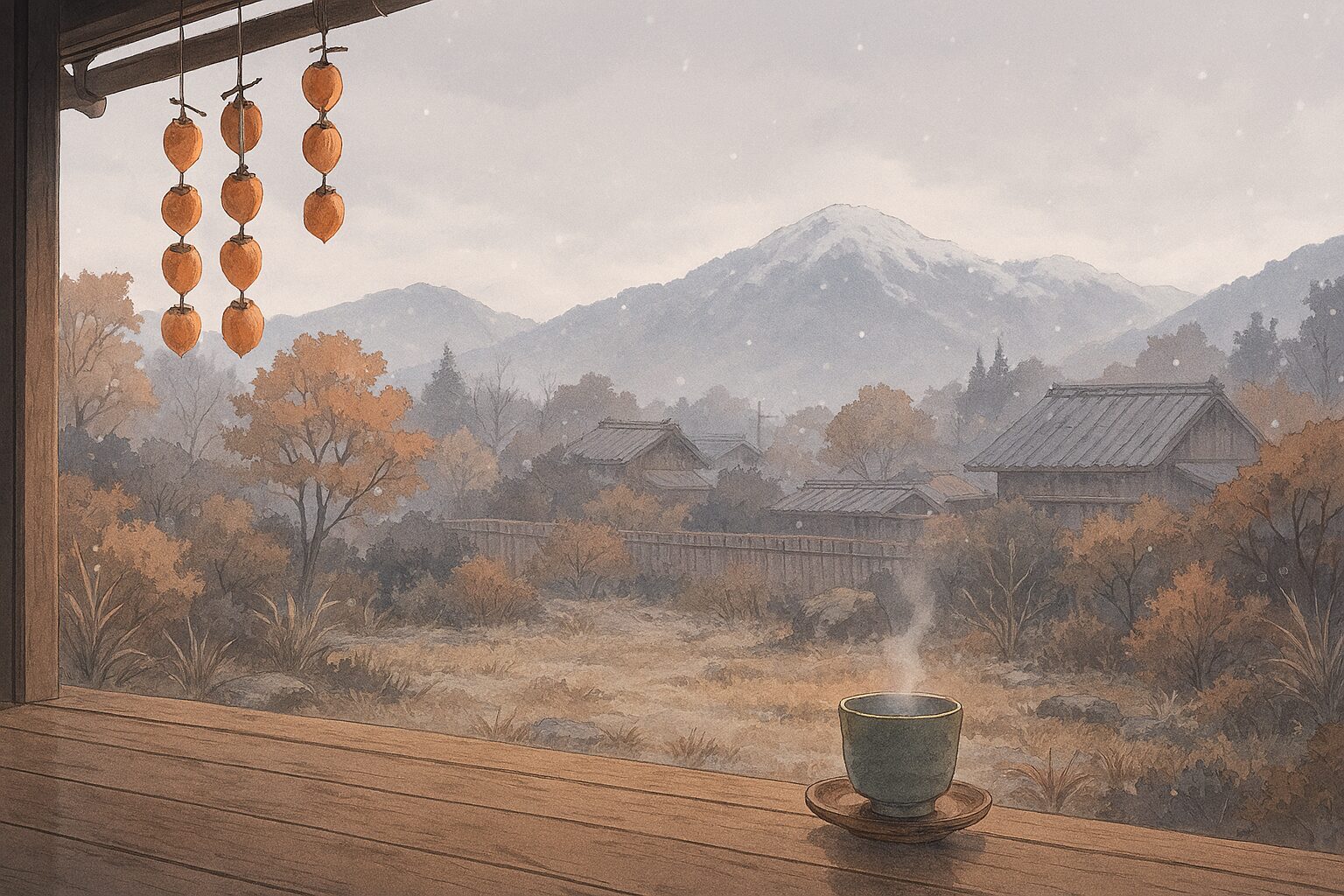If you turn the page of a traditional Japanese calendar to November 22nd, you might notice small characters written beneath the date reading “Shōsetsu” (小雪). This isn’t just a weather forecast. It is one of the “Nijūshi Sekki” (The 24 Solar Terms), an ancient Japanese calendar system that captures the subtle transitions of the seasons.
The 24 Solar Terms divide the year into 24 equal parts based on the sun’s movement, each named to reflect the season. Shōsetsu is the 20th term. Literally translating to “Small Snow,” it doesn’t necessarily mean it will snow on this day. Rather, it signifies a meteorological gradient: “The time when the first snow begins to flutter in the mountains, the north wind strengthens in the plains, and signs of winter begin to arrive.”
Between the End of Autumn and the Beginning of Winter
During this period, Japan undergoes a magical transformation of color. The vivid reds and yellows of the autumn leaves (*Momiji*) are gradually scattered to the ground by the *Kogarashi* (cold wintry wind), and the world shifts into the muted tones of winter. The sunlight weakens, and sunsets come earlier, but the harshness of deep winter (*General Winter*) has not yet arrived. This ambiguity—”not quite winter, but certainly heading there”—is the essence of Shōsetsu.
In Japanese poetry and literature, the rain during this season is often called *Shigure*. It refers to a cold rain that starts suddenly and stops just as quickly. The period of Shōsetsu can be seen as nature’s preparation time to get ready for the coming cold.
Decoding Japanese Culture Through Shōsetsu: The Aesthetics of Preparation and Preservation
When Shōsetsu arrives, a symbolic scene unfolds in Japanese households and rural villages: the preparation of Preserved Food. Because winter in parts of Japan can be severe, ancestors developed the wisdom to process food during this time to survive the cold months.
1. The Scenery of Sun-Drying
Traveling through the Japanese countryside, you may see eaves of houses draped with hanging *Daikon Radish* or *Persimmons*. Exposing them to the cold, dry wind of Shōsetsu removes moisture and concentrates their flavor.
- Hoshigaki (Dried Persimmons): By drying astringent persimmons, they transform into incredibly sweet, natural confections. The white powder that forms on their surface is a poetic symbol of Japanese winter.
- Kiriboshi Daikon (Dried Radish): Daikon radishes bathed in sunlight see their nutritional value multiply significantly.
2. Oseibo: The Culture of Gift-Giving
Shōsetsu also signals the start of preparations for *Oseibo*, the year-end gift-giving tradition. Oseibo involves sending gifts to those who have helped you throughout the year to express gratitude. Being mindful of the changing seasons, caring for the recipient’s health, and wishing for a continued good relationship in the coming year—the Japanese spirit of *Wa* (Harmony) breathes within this calendar event.
3. The Coloring of Yuzu
This is also the time when Yuzu fruits in the garden turn a vivid yellow. The fragrant Yuzu is not only a culinary accent but also builds anticipation for the Yuzu Bath (Yuzu-yu) taken on the upcoming Winter Solstice.
[Trivia] Another Face of November 22nd
Incidentally, in modern Japan, November 22nd is also known as “Good Couple Day” (Ii Fuufu no Hi). Derived from a play on numbers—11 (Ii/Good) and 22 (Fuufu/Couple)—it has become a day to express gratitude to one’s partner. The traditional “Shōsetsu” and the modern “Good Couple Day.” When these two coincide, it creates a day that warms both body and soul.
Are You Ready to Embrace the Silence?
Modern society is always bright, warm, and convenient. However, the solar term of Shōsetsu teaches us that “coldness” and “darkness” are also parts of nature, and there is a beauty found only by accepting them.
It is because the cold increases that hot pot dishes (*Nabe*) taste so delicious. It is because the days get shorter that we can enjoy reading or conversation during the long nights. Feeling the richness within inconvenience might just be the true essence of Japanese culture.
How do you perceive the “beginning of winter” in your country? Do you simply endure it as a cold season? Or, like the Japanese, do you find preparation and joy for the next season within the chilly wind?
This November 22nd, look up at the sky. If weak sunlight filters through the clouds or a cold breeze strokes your cheek, it might be “Shōsetsu” greeting you.
Reference (Japanese Calendar & Astronomy):
National Astronomical Observatory of Japan
Category:
What’s Today’s Special Day Series
冬の気配が、静かに足音を立ててやってくる。「小雪(Shōsetsu)」とは何か?
日本のカレンダーをめくると、11月22日の日付の下に小さな文字で「小雪(Shōsetsu)」と書かれていることに気づくかもしれません。これは単なる天気予報ではありません。日本の古い暦である「二十四節気(Nijūshi Sekki)」の一つであり、季節の微妙な変化を捉えた美しい言葉です。
二十四節気とは、太陽の動きを元に1年を24等分し、それぞれに季節を表す名前をつけたものです。小雪は20番目の節気にあたります。文字通り「Small Snow(小さな雪)」を意味しますが、この日が必ず雪になるわけではありません。「山岳地帯では初雪が舞い始める頃であり、平地でも北風が強くなり、冬の到来を感じ始める時期」という、気象のグラデーションを示しているのです。
秋の終わりと、冬の始まりの狭間で
この時期、日本は魔法のような色彩の変化を見せます。紅葉(Momiji)の鮮やかな赤や黄色は、北風(Kogarashi)によって少しずつ地面へと散り落ち、世界は徐々に冬の落ち着いた色調へと変化していきます。陽の光は弱まり、日没は早くなりますが、まだ本格的な冬将軍(厳冬)は到着していません。この「本格的な冬ではないが、確実に冬に向かっている」という曖昧さこそが、小雪の風情なのです。
日本の詩歌や文学では、この時期の雨を「時雨(Shigure)」と呼び、突然降り出し、すぐに止む冷たい雨として愛でてきました。小雪の時期は、まさに自然界が冬支度を整えるための準備期間と言えるでしょう。
小雪から読み解く日本文化:保存と準備の美学
小雪の時期を迎えると、日本の家庭や農村では象徴的な光景が見られます。それは「保存食(Preserved Food)」の準備です。日本の冬は地域によっては非常に厳しいため、先人たちはこの時期に食料を加工し、冬を乗り切る知恵を育んできました。
1. 天日干しの風景
日本の田舎を旅すると、家の軒先に大量の「大根(Daikon Radish)」や「柿(Persimmons)」が吊るされているのを目にするでしょう。これらは、冷たく乾燥した小雪の風に晒すことで、水分を抜き、旨味を凝縮させています。
- 干し柿(Hoshigaki): 渋柿を干すことで、驚くほど甘い天然のスイーツに変わります。白い粉を吹いた干し柿は、日本の冬の風物詩です。
- 切り干し大根(Kiriboshi Daikon): 太陽の光を浴びた大根は、栄養価が何倍にも跳ね上がります。
2. お歳暮(Oseibo):感謝を贈る文化
小雪はまた、年末の贈り物である「お歳暮」の準備を始める合図でもあります。お歳暮とは、今年一年お世話になった人へ感謝の気持ちを込めて品物を贈る習慣です。季節の変わり目を意識し、相手の健康を気遣い、次の年も良い関係を築きたいと願う。日本人の「和(Harmony)」の精神が、この暦の中に息づいています。
3. 柚子(Yuzu)の色づき
庭先の柚子の実が鮮やかな黄色に色づくのもこの頃です。香り高い柚子は、料理のアクセントとしてだけでなく、来るべき冬至(Winter Solstice)の柚子湯に向けての期待感を高めてくれます。
【豆知識】11月22日のもう一つの顔
ちなみに、現代の日本では11月22日は「いい夫婦の日(Good Couple Day)」としても知られています。「11(いい)22(ふうふ)」という語呂合わせから来ており、パートナーに感謝を伝える日として定着しています。伝統的な「小雪」と、現代的な「いい夫婦の日」。この二つが重なる日は、心も体も温めたくなる一日です。
静寂を受け入れる準備はできていますか?
現代社会は常に明るく、暖かく、便利です。しかし、小雪という節気は、私たちに「寒さ」や「暗さ」もまた自然の一部であり、それを受け入れることで見えてくる美しさがあることを教えてくれます。
寒さが増すからこそ、温かい鍋料理(Nabe)が美味しく感じられる。日が短くなるからこそ、長い夜に読書や会話を楽しむことができる。不便さの中にある豊かさを感じることこそ、日本文化の真髄かもしれません。
あなたは、自分の国で「冬の始まり」をどのように感じますか?ただ寒いだけの季節としてやり過ごしますか?それとも、日本人のように、冷たい風の中に次の季節への準備と喜びを見出しますか?
今年の11月22日は、空を見上げてみてください。もし雲の間から弱い日差しが漏れていたり、冷たい風が頬を撫でたりしたら、それは「小雪」があなたに挨拶をしているのかもしれません。
参考リンク(日本の暦と天文学):
国立天文台 暦計算室 (National Astronomical Observatory of Japan)



コメント